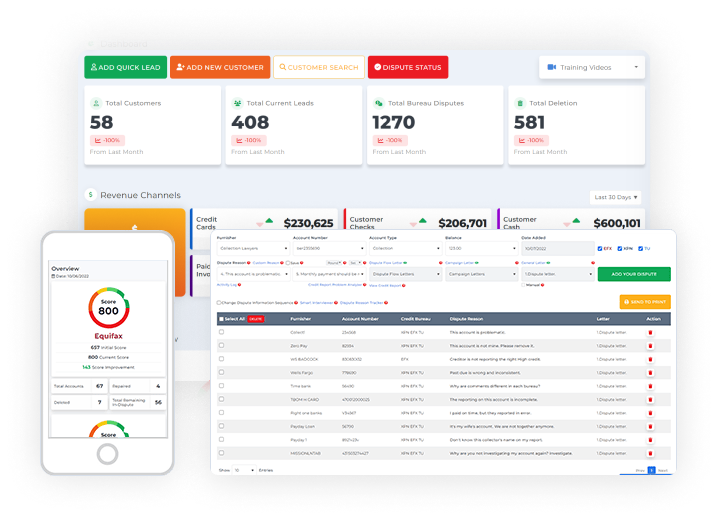This content is a transcript of the video above.
In this article, I’m going to show you the 3-Step Collection Dispute Letter system, the same exact thing that I use when I had inaccurate collection accounts on my credit report and actually when I was helping other consumers improve their credit scores as well.
Step 1: Get a Copy Of Your Credit Report & Dispute

The first thing you need to do to make the collection dispute letter system work is you need to get a copy of your credit report and review your credit report for inaccurate information. And then you want to draft up a letter, and you want to send that letter to the credit bureaus, and you’re going to be disputing the inaccurate collection accounts on your credit report.
You got to give the credit bureau 30 days to investigate and you also got to give them five days for the mail to get to them and five days for the mail to come back. Once you get a result back from the credit bureau, your result is either going to be deleted, or your result is going to be verified with no change.
Now verified no change basically means they did their investigation. They reached out to the collection agency, and the collection agency verified. What you need to do next is that you need to draft a simple letter to the collection agency.
You’re going to draft a simple information request to the collection agency. You’re not sending them a debt validation. You’re only asking them for information.
So you’re going to draft the letter, or you can use the letter I’m going to give you, and you’re going to ask the collection agency to send you all of the information that they have pertaining to the debt that they verified with the credit bureau.
Remember, you just disputed it with the credit bureau. Now, you got to reach out to the collector and say, “Give me all the information, I would like to know the information about this particular debt.” Now, two things are going to happen.
The collection agency is either going to send you all of the information that’s pertaining to that particular account, right, the information that they have, or they’re not going to send you anything.
Step 2: Look for Inconsistencies

There are two things going to happen. One, they’re going to ignore you, or two, they’re going to send you information back to you, back to the mail, right, through the mail.
Once you get the information from the collection agency, what you want to do is you want to take the information that they sent you pertaining to the debt that they’re reporting on your credit report, and then you want to get your credit report and you want to study both.
When you’re studying both, what you’re doing is you looking for the inconsistency or you’re looking to see what they’re reporting on their information, is it the same information that the credit bureau is reporting on your credit report?
So you’re looking for inaccurate information. Say, for example, the collection agency sent you their information and they’re reporting one balance, but on the credit report, it shows a different balance. The collection agency information has a different account number, but on the credit report, it has a different account number so the information that the collection agency sent.
The information that they use to validate this debt with the credit bureau. That information is not consistent with the information that’s reported by the collection agency. And this is very important for working collection dispute letter system.
This is the reason why you want the collection agency to send you information. You’re not disputing the debt with the collection agency. You’re not sending a debt validation. You’re just asking for info. You do this so you can do your investigation. So you got the collection, and agency’s info. Now, you compare it.
Step 3: What to Do When You Find The Inconsistencies?

We need to know what to do now that you got the information from the collector. Let’s talk about first what happens if they don’t respond to your request. If they don’t respond to your request, you just simply draft a second collection dispute letter to the credit bureau, and you simply say that you reached out to the collection agency.
You requested proof, and information to validate the debt that they’re reporting on the credit report and the collector failed to respond. And because they failed to respond, they cannot validate this debt.
I’m asking you, the credit bureau, to delete this information from my credit report, this inaccurate, misleading, or wrong information from my credit report. Now, that is the letter that you draft when the collector does not respond to your information request.

But safe example, they did respond to your information request, as I mentioned in step two. What you’re going to do now is you’re going to draft a dispute letter, and I’m going to give you that letter that you’re going to send to the credit bureau as well in my three-step package that I’m going to give you for absolutely free.
What you’re going to do is you’re going to draft the letter to the credit bureau, and you’re going to point out all of the inconsistencies. You’re going to tell them, “Hey, look, the collection agency sent me information pertaining to this debt that’s on my credit report, this collection account, and I noticed that there’s a lot of inconsistencies. There are a lot of things that are not matching.
Conclusion
The first letter that you sent to the credit bureau, is the initial letter. I’m also going to give you the letter, the information request letter that you send to the collection agency as well. And then I’m going to give you the third letter, the follow-up letter that you send to the credit bureau, asking them to delete the inaccurate information that’s not properly verified by the collection agency.
And all you have to do right now is click the link anywhere below this article. Anywhere, you’re going to get all three of the letters for absolutely free. I don’t want to see any inaccurate information on your credit report and it’s not right, because the Fair Credit Reporting Act gives us. Take care.



